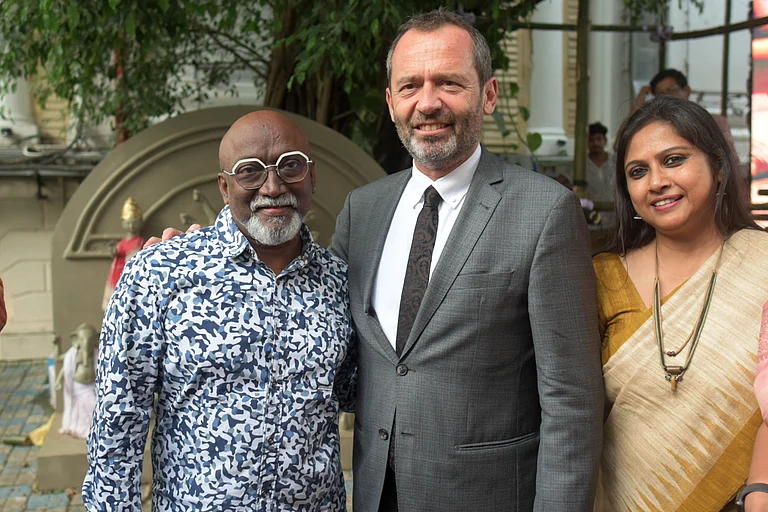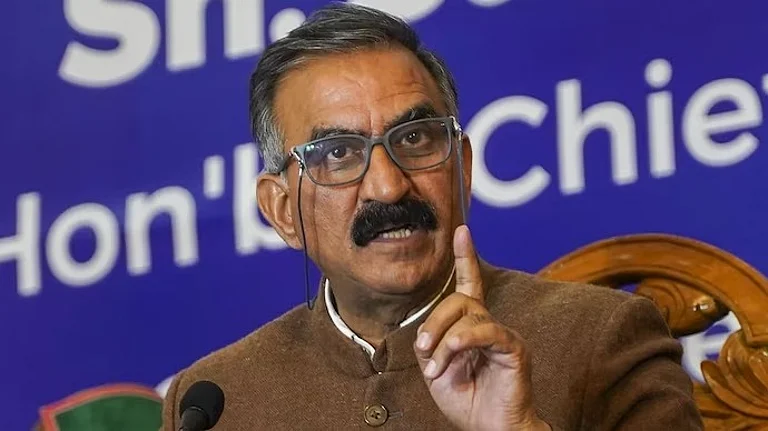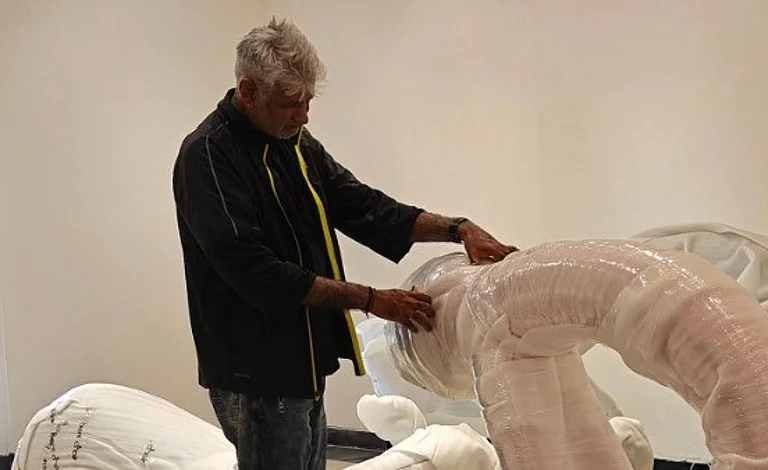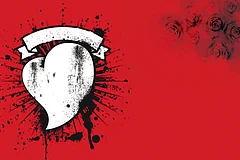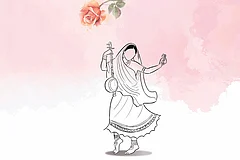A yellow tarp wall with myriad cow dung cakes forms the centre stage of conceptual artist Mayuri Chari’s latest exhibit. The almost bucolic landscape changes when one steps closer to the wall and the dung cakes take on a familiar shape. They start to look like vaginas. In fact, they are vaginas moulded in cow dung, a take on the holiness attributed to the cow and the stigma of menstruation that women must undergo.
Chari, who hails from a village in Goa, often felt like an outcast when she would get her periods. She became the untouchable. “In our country, cow dung is considered pure enough to be used in religious rituals but menstruating women are banished,” she says. The yellow tarp has many associations for her—of rains, slums, temporary homes and a shield itself. The vaginas are pasted on this yellow in parallel lines, almost giving a sense of discipline akin to military ranks. They subsume everything else around them. It is provocative, disruptive and familiar.

Through the series titled ‘Does Everything Belong To Me?’ exhibited recently at the 15th India Art Fair, Chari tries to raise questions about body politics, exploitation and hegemonic fetishisation of female labour.
While depicting the universal female experience of being the ‘other’, Chari’s work also sheds light on the exploitation of women’s labour in informal sectors. The tarp is a reminder of the sarees these migrant workers from Maharashtra’s Kolhapur region use as walls of privacy in the overcrowded labour camps they live in for months. “These women are asked to remove their uterus so that they don’t fall sick while menstruating in unhygienic conditions and miss work,” Chari states.

When women look for muses, they seem to find broken hearts, often their own. Chari’s stitch-work, which builds on the Portuguese-Goan tradition of trousseau stitching, reflects a personal urgency to be heard over injustice and erasure. This need to be seen, heard and felt remains constant among the women created by women at the art fair.
Baaraan Ijlal’s portraits of women depict frugality —the leanest of life’s offerings. They remain the sole spectators of their own tragedies. Titled ‘I Didn’t Ask For Fish Bones: Notes on Songs of Abundance’ is an attempt at “bearing witness of the invisible losses that women live with”, says the Bhopal-born artist. Her searing portrayals of anonymous subjects—like the woman who lost an eye in the 1984 gas tragedy or the schizophrenic woman who looks like a bird—are not just emotive but hang in stark contrast to the opulence of the annual fair, which brought together 109 exhibitions and works of 72 galleries this year.

It isn’t just erasure of the body that these artworks highlight. Some of the artists tackle questions of economic and political erasure. In ‘Ghar Ki Laxmi’, Sonal Varshney brings together a collage of portraits of women in a bid to highlight the various invisible ways in which women contribute to the household economy without any recognition, credit or dividend.
Artist Shilpa Gupta’s line drawings depict police brutality and censorship in a bid to fight another kind of erasure. “The absent, dissenting body, despite its expulsion, affirms its prescience by claiming space and encircling the area around the presence,” she says. Drawn between 2014 and now, the series titled ‘Nothing Will Go On Record’ is one of the rare pieces of protest at the fair.

The Female Perspective
Born in Ballia, Uttar Pradesh, Pallavi Singh was always bothered by the perception of “beauty and grooming” specifically as a female trait. Her portraits, a part of her ‘The Bather’ series, depict men preening and brushing their hair in front of a mirror. These men have a candid, soft, sensual demeanour. “Whenever we think of beauty or bathing, we only think of women because all imagery around it depicts women, usually painted or created by men. With this series, I have tried to invert the male gaze by depicting how a man in his intimate moments might look like when seen by a woman,” she states.
The ‘female gaze’ was centre stage in the works of Shilo Shiva Suleman and Kanchan Chander as well. Suleman’s golden sculpture declares to the world that ‘God is a Woman in Love’ and forms the centrepiece of the ‘Venusian kingdom of overgrown orchids’. The gilded portraits that form part of the collection delve into the folds of Hindu mythology for its erotic undercurrents. Chander depicts the female form in its most corporeal, without face or limbs, a nameless entity that bears pain and suffering but is also the source of strength, resilience and birth. Chander also feels drawn to portraits of ‘tragedy queens’. In her series Hollywood-Bollywood, while the busts are decorated by kitschy prints of Amrita Pritam and Freida Kahlo, the bejewelled eyes of Meena Kumari, Audrey Hepburn, and Marilyn Monroe follow one around the gallery. In contrast, the melancholy padded canvasses created by Anju Dodiya as part of her ‘Bridge of Restlessness’ collection evoke a sense of “mournful restlessness”. She, too, draws from tragic women from the past.
Memory Archival
Do women artists look to themselves for inspiration? Ekta Singha agrees that there is a propensity among women to look at the lives of other women. The urgency may come from a subconscious need to fight one’s own erasure. In her textile-based mural, which serves as a memory archive of her mixed Indian and Bangladeshi roots, Singha uses layers to evoke the passage of time and the onset of anomie.
Sadhna Prasad’s mural, which morphs when seen through the lens of an iPad app, also reveals a complex reality. Prasad, who is one of the Digital Artists in Residence at the fair this year, uses augmented reality to depict the contiguities of environmentalism, class and thoughtless urbanisation.
The histories and alternate realities these women try to bring forth are largely stories of women and the marginalised that remain in the footnotes. The focus on “universality”, however, fails to bring into account the hierarchies of neglect that women face. Some have historically remained more vulnerable to abuse based on their socio-political-economic position.
MORE FROM THIS ISSUE
Even in the world of art, privilege remains key to access. Near the end of the last pavilion in the art fair was a booth containing artworks by tribal artists like Bhuri Devi. The veteran Bhil artist was awarded the Padma Shri in 2021 for her contributions to Indian and indigenous art. She remains absent from the event. This is the first time that Bhuri Devi, in her nearly 70 years of being an artist, has made it to a commercial, high-end, global space like the India Art Fair. While the artists at the India Art Fair attempt to bring out erasure and alternate histories, the space itself remains excessively exclusive.







